Operator ESA SATCAT no. 39479 Launch date 2013 Launch mass 2,029 kg Cost 650 million EUR | COSPAR ID 2013-074A Website sci.esa.int/gaia/ Period 5.9 months Launch mass 2,029 kg | |
 | ||
Mission type Astrometric observatory Mission duration planned: 5 years; possible extension by one to four yearselapsed: 3 years, 2 months and 18 days Similar Herschel Space Observatory, INTEGRAL, Rosetta, Venus Express, Planck | ||
Gaia is a space observatory of the European Space Agency (ESA) designed for astrometry. The mission aims to construct the largest and most precise 3D space catalog ever made and totalling approximately 1 billion astronomical objects, mainly stars but also planets, comets, asteroids and quasars among others. The spacecraft will monitor each of its target stars about 70 times over a period of five years to study the precise motion of each star relative to the Milky Way galaxy. This will involve approximately 1% of the Milky Way population with all stars brighter than magnitude 20 in a broad photometric band that covers most of the visual range. Additionally, Gaia is expected to detect thousands to tens of thousands of Jupiter-sized exoplanets beyond the Solar System, 500,000 quasars and tens of thousands of new asteroids and comets within the Solar System.
Contents
- History
- Objectives
- Spacecraft
- Scientific instruments
- Measurement principles
- Data processing
- Launch and orbit
- Stray light problem
- Mission progress
- Data releases
- References

Gaia will create a precise three-dimensional map of astronomical objects throughout the Milky Way and map their motions, which encode the origin and subsequent evolution of the Milky Way. The spectrophotometric measurements will provide the detailed physical properties of all stars observed, characterizing their luminosity, effective temperature, gravity and elemental composition. This massive stellar census will provide the basic observational data to tackle a wide range of important questions related to the origin, structure, and evolutionary history of our galaxy.
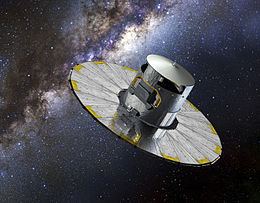
Successor to the Hipparcos mission, the telescope is part of ESA's Horizon 2000+ long-term scientific program. Gaia was launched on 19 December 2013 by Arianespace using a Soyuz ST-B/Fregat-MT rocket flying from Kourou in French Guiana. The spacecraft currently operates in a Lissajous orbit around the Sun–Earth L2 Lagrangian point.
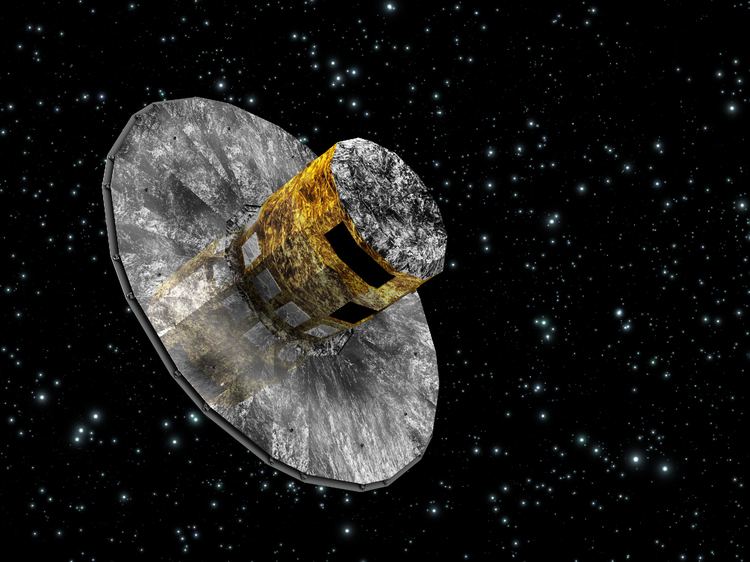
History
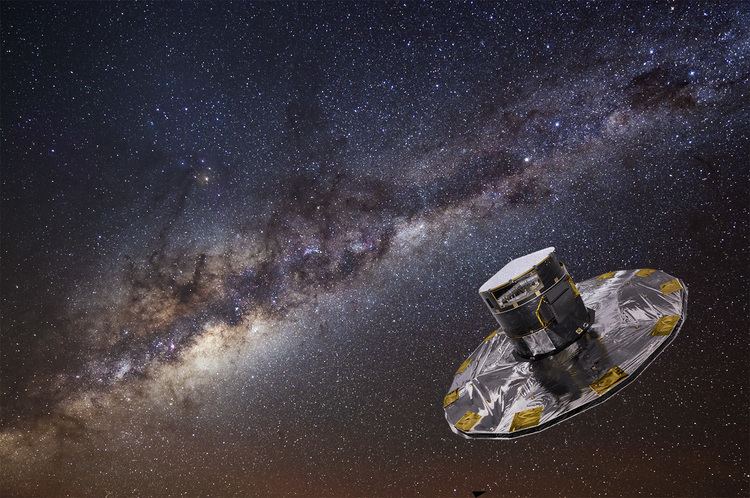
The Gaia space telescope has its roots in ESA's Hipparcos mission (1989–1993). Its mission was proposed in October 1993 by Lennart Lindegren (Lund University, Sweden) and Michael Perryman (ESA) in response to a call for proposals for ESA's Horizon Plus long-term scientific programme. It was adopted by ESA's Science Programme Committee as cornerstone mission number 6 on 13 October 2000, and the B2 phase of the project was authorised on 9 February 2006, with EADS Astrium taking responsibility for the hardware. The name "Gaia" was originally derived as an acronym for Global Astrometric Interferometer for Astrophysics. This reflected the optical technique of interferometry that was originally planned for use on the spacecraft. While the working method evolved during studies and the acronym is no longer applicable, the name Gaia remained to provide continuity with the project.
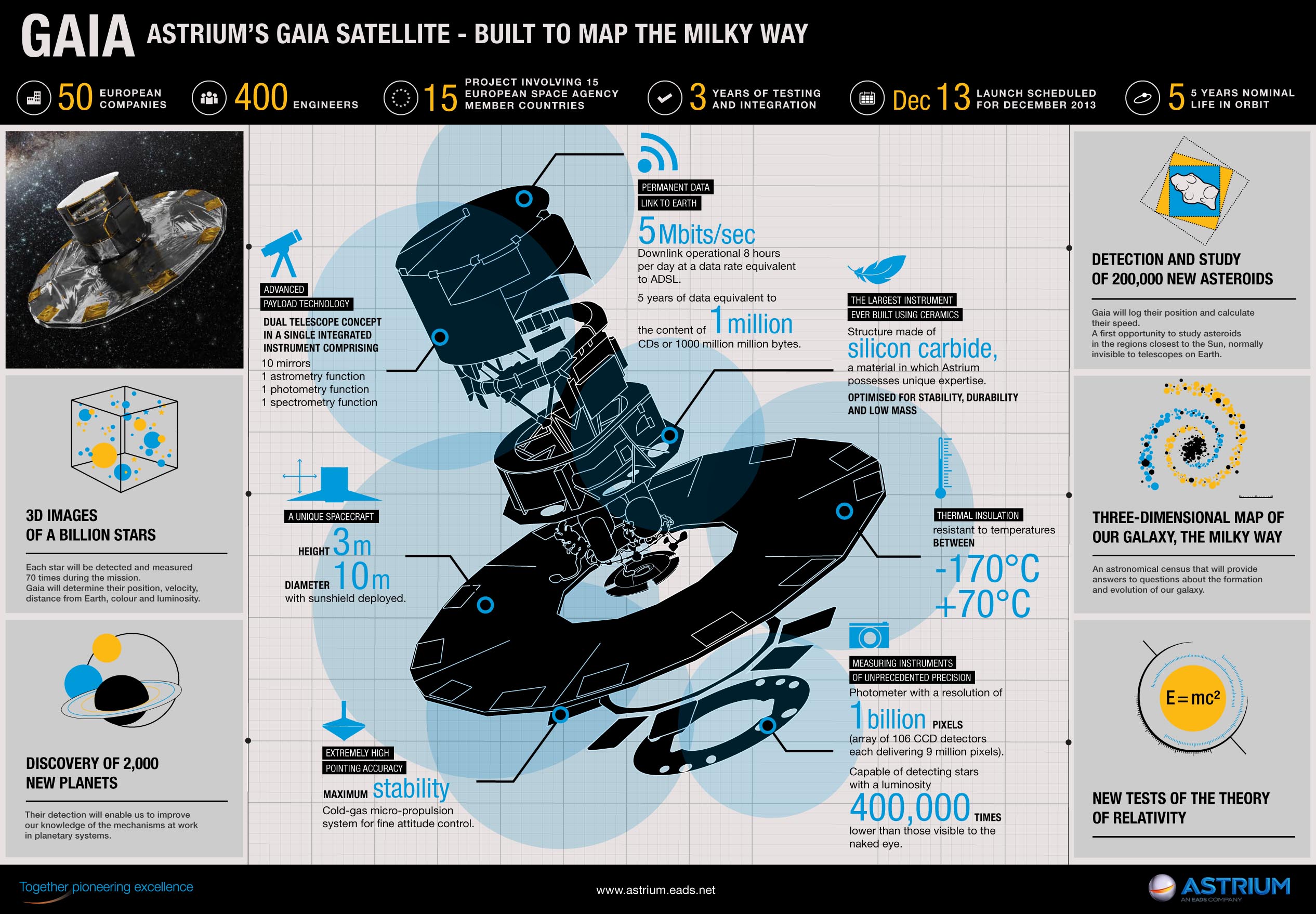
The total cost of the mission is around €740 million (~ $1 billion), including the manufacture, launch and ground operations. Gaia was completed two years behind schedule and 16% above its initial budget, mostly due to the difficulties encountered in polishing Gaia's ten mirrors and assembling and testing the focal plane camera system, as well as other issues.
Objectives
The Gaia space mission has the following objectives:
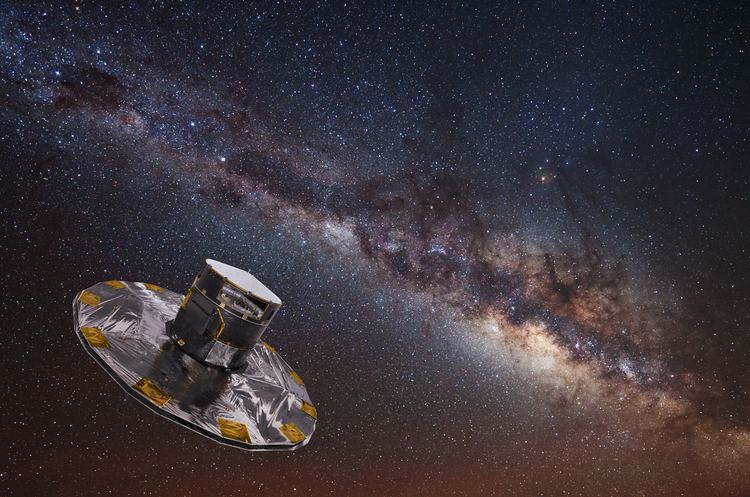
In order to achieve these objectives, Gaia has these goals:
Spacecraft
Gaia was launched by Arianespace, using a Soyuz ST-B rocket with a Fregat-MT upper stage, from the Ensemble de Lancement Soyouz at Kourou in French Guiana on 19 December 2013 at 09:12 UTC (06:12 local time). The satellite separated from the rocket's upper stage 43 minutes after launch at 09:54 UTC. The craft headed towards the Sun–Earth Lagrange point L2 located approximately 1.5 million kilometres from Earth, arriving there 8 January 2014. The L2 point provides the spacecraft with a very stable gravitational and thermal environment. There it uses a Lissajous orbit that avoids blockage of the Sun by the Earth, which would limit the amount of solar energy the satellite could produce through its solar panels, as well as disturb the spacecraft's thermal equilibrium. After launch, a 10-metre diameter sunshade was deployed. The sunshade always faces the Sun, thus keeping all telescope components cool and powering Gaia using solar panels on its surface.
Scientific instruments
The Gaia payload consists of three main instruments:
- The astrometry instrument (Astro) precisely determines the positions of stars of magnitude 5.7 to 20 by measuring their angular position. By combining the measurements of any given star over the five-year mission, it will be possible to determine its parallax, and therefore its distance, and its proper motion —the velocity of the star projected on the plane of the sky.
- The photometric instrument (BP/RP) allows the acquisition of luminosity measurements of stars over the 320–1000 nm spectral band, over the same magnitude 5.7–20. The blue and red photometers (BP/RP) are used to determine stellar properties such as temperature, mass, age and elemental composition. Multi-colour photometry is provided by two low-resolution fused-silica prisms dispersing all the light entering the field of view in the along-scan direction prior to detection. The Blue Photometer (BP) operates in the wavelength range 330–680 nm; the Red Photometer (RP) covers the wavelength range 640–1050 nm.
- The Radial-Velocity Spectrometer (RVS) is used to determine the velocity of celestial objects along the line of sight by acquiring high-resolution spectra in the spectral band 847–874 nm (field lines of calcium ion) for objects up to magnitude 17. Radial velocities are measured with a precision between 1 km/s (V=11.5) and 30 km/s (V=17.5). The measurements of radial velocities are important to correct for perspective acceleration which is induced by the motion along the line of sight." The RVS reveals the velocity of the star along the line of sight of Gaia by measuring the Doppler shift of absorption lines in a high-resolution spectrum.
In order to maintain the fine pointing to focus on stars many light years away, there are almost no moving parts. The spacecraft subsystems are mounted on a rigid silicon carbide frame, which provides a stable structure that will not expand or contract due to heat. Attitude control is provided by small cold gas thrusters that can output 1.5 micrograms of nitrogen per second.
The telemetric link with the satellite is about 3 Mbit/s on average, while the total content of the focal plane represents several Gbit/s. Therefore, only a few dozen pixels around each object can be downlinked.
Measurement principles
Despite its name, Gaia does not actually use interferometry to determine the positions of stars. At the time of the original design, interferometry seemed the best way to achieve the target resolution, but the design later evolved into an imaging telescope. Similar to its predecessor Hipparcos, but with a precision one hundred times better, Gaia consists of two telescopes providing two observing directions with a fixed, wide angle of 106.5° between them. The spacecraft rotates continuously around an axis perpendicular to the two telescopes' lines of sight. The spin axis in turn has a slight precession across the sky, while maintaining the same angle to the Sun. By precisely measuring the relative positions of objects from both observing directions, a rigid system of reference is obtained.
The two key telescope properties are:
Each celestial object will be observed on average about 70 times during the mission, which is expected to last five years. These measurements will help determine the astrometric parameters of stars: two corresponding to the angular position of a given star on the sky, two for the derivatives of the star's position over time (motion) and lastly, the star's parallax from which distance can be calculated. The radial velocity of the brighter stars is measured by an integrated spectrometer observing the Doppler effect. Because of the physical constraints imposed by the Soyuz spacecraft, Gaia's focal arrays could not be equipped with optimal radiation shielding, and ESA expects their performance to suffer somewhat toward the end of the five-year mission. Ground tests of the CCDs while they were subjected to radiation provided reassurance that the primary mission's objectives can be met.
The expected accuracies of the final catalogue data have been calculated following in-orbit testing, taking into account the issues of stray light, degradation of the optics, and the basic angle instability. The best accuracies for parallax, position, and proper motion are obtained for the brighter observed stars, apparent magnitudes 3-12. The standard deviation for these stars is expected to be 6.7 micro-arc seconds or better. For fainter stars, error levels increase, reaching 26.6 micro-arc seconds error in the parallax for 15th magnitude stars, and several hundred micro-arc seconds for 20th magnitude stars. For comparison, the best parallax error levels from the new Hipparcos reduction are no better than 100 micro-arc seconds, with typical levels several times larger.
Data processing
The overall data volume that will be retrieved from the spacecraft during the five-year mission assuming a nominal compressed data rate of 1 Mbit/s is approximately 60 TB, amounting to about 200 TB of usable uncompressed data on the ground, stored in the InterSystems Caché database. The responsibility of the data processing, partly funded by ESA, is entrusted to a European consortium, the Data Processing and Analysis Consortium (DPAC), which was selected after its proposal to the ESA Announcement of Opportunity released in November 2006. DPAC's funding is provided by the participating countries and has been secured until the production of Gaia's final catalogue scheduled for 2020.
Gaia sends back data for about eight hours every day at about 5 Mbit/s. ESA's two most sensitive ground stations, the 35 m diameter radio dishes in Cebreros, Spain, and New Norcia, Australia, receive the data.
Launch and orbit
In October 2013 ESA had to postpone Gaia's original launch date, due to a precautionary replacement of two of Gaia's transponders. These are used to generate timing signals for the downlink of science data. A problem with an identical transponder on a satellite already in orbit motivated their replacement and reverification once incorporated into Gaia. The rescheduled launch window was from 17 December 2013 to 5 January 2014, with Gaia slated for launch on 19 December.
Gaia was successfully launched on 19 December 2013 at 09:12 UTC. About three weeks after launch, on 8 January 2014, it reached its designated orbit around the SEL2 point, about 1.5 million kilometers from Earth.
The ephemeris of Gaia satellite and the field of view map can be computed with the help of the public dedicated web-interface Gaiainthesky for any location on Earth.
In 2015 an object was discovered orbiting the Earth and designated by the Minor Planet Center as object 2015 HP116. It was soon found to be an accidental rediscovery of the Gaia spacecraft and the designation was retracted.
Stray light problem
Shortly after launch, ESA revealed that Gaia was suffering from a stray light problem. The problem was initially thought to be due to ice deposits causing some of the light diffracted around the edges of the sunshield and entering the telescope apertures to be reflected towards the focal plane. The source of the stray light was later identified as the fibers of the sunshield, protruding beyond the edges of the shield. This results in a "degradation in science performance [which] will be relatively modest and mostly restricted to the faintest of Gaia's one billion stars." Mitigation schemes are being implemented to optimise the mission performance. The degradation is more severe for the RVS spectrograph than for the astrometry measurements, and only affects the fainter stars.
Mission progress
The testing and calibration phase, which started while Gaia was en route to SEL2 point, continued until the end of July 2014, three months behind schedule due to unforeseen issues with ice deposits and stray light entering the detector. After the six-month commissioning period, the satellite started its nominal five-year period of scientific operations on 25 July 2014 using a special scanning mode that intensively scanned the region near the ecliptic poles; on 21 August 2014 Gaia began using its normal scanning mode which provides more uniform coverage.
Although it was originally planned to limit Gaia's observations to stars fainter than magnitude 5.7, tests carried out during the commissioning phase indicated that Gaia could autonomously identify stars as bright as magnitude 3. When Gaia entered regular scientific operations in July 2014, it was configured to routinely process stars in the magnitude range 3 – 20. Beyond that limit, special procedures are used to download raw scanning data for the remaining 230 stars brighter than magnitude 3; methods to reduce and analyse these data are being developed; and it is expected that there will be "complete sky coverage at the bright end" with standard errors of "a few dozen µas".
On 12 September 2014, Gaia discovered its first supernova in another galaxy. On 3 July 2015, a map of the Milky Way by star density was released, based on data from the spacecraft. As of August 2016, "more than 50 billion focal plane transits, 110 billion photometric observations and 9.4 billion spectroscopic observations have been successfully processed."
Data releases
The Gaia catalogue will be released in stages; it is expected that the early releases will be incomplete, especially for fainter stars located in dense star fields. The first data release, Gaia DR1, based on 14 months of observations made through September 2015, took place on 13 September 2016. The data release includes "positions and … magnitudes for 1.1 billion stars using only Gaia data; positions, parallaxes and proper motions for more than 2 million stars" based on a combination of Gaia and Tycho-2 data for those objects in both catalogues; "light curves and characteristics for about 3000 variable stars; and positions and magnitudes for more than 2000 … extragalactic sources used to define the celestial reference frame". Data from this DR1 release can be accessed at the Gaia archive, as well as through astronomical data centers such as CDS.
The second data release (DR2), scheduled for April 2018, will include positions, parallaxes and proper motions for about a billion stars with acceptable formal standard errors in position, red and blue photometric data for all stars, and radial velocity measurements for many simple cases. The third data release potentially will include orbital solutions for many binary stars and classifications for spectroscopically "well behaved" objects. The fourth data release potentially will include variable star classifications, solar system results, and non single-star catalogues. The complete final Gaia catalogue is currently scheduled for 2022, three years after the end of the nominal mission. The number of releases between DR2 and the final release has not yet been decided.
An outreach application, Gaia Sky, has been developed to explore the galaxy in three dimensions using Gaia data.
